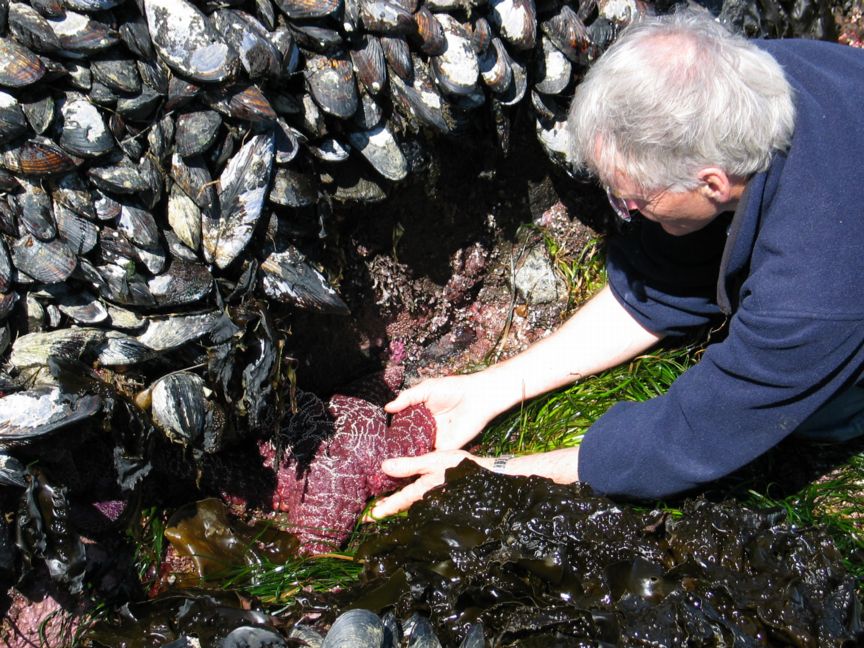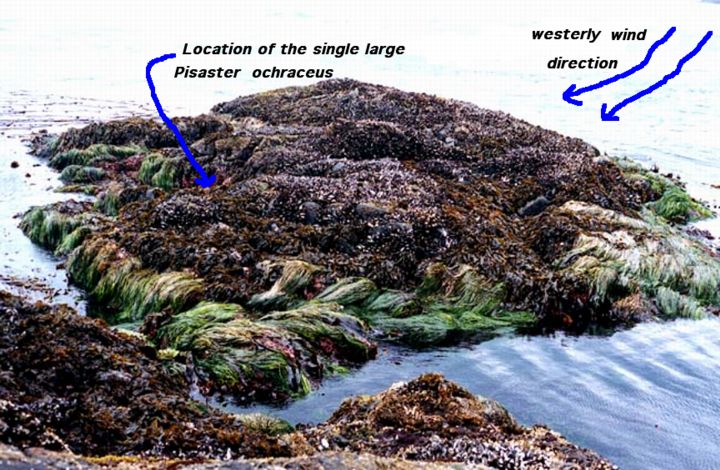- Large 40 cm specimen in the one location at Race Rocks
- Habitat of Pisaster ochraceus at a 0 tidal level
Along the low intertidal shores of Vancouver Island, this sea star is frequently found. It is amazing however that this is the only specimen we have been able to find at RaceRocks. Since these sea stars inhabit the lower intertidal zone they are subject to strong forces by crashing waves. This single individual with a diameter of over 50 cm. has a protected niche at the inside base of the cliff in a crevice on the small intertidal island on the West side of Great Race Rocks. Its main food, Californianus mussels are abundant all around so it has probably been in this same position for more than 20 years.
The Pisaster ochraceus or ochre star as it is more commonly known can be found along the coast of the Pacific Ocean from the Baja California up to Alaska. However it is more common around the Northwest coast as it is a cold water species. Ochre stars typically have five arms and are dotted with small white blunt spines which form line patterns. The bottoms of their arms are covered in small extendable suction like feet.
The ochre star mainly eats mussels, snails, limpets, chitons, barnacles or sea urchins. By moving on top of its prey, the ochre star then opens the shell and everts its stomach onto its prey digesting it. The ochre star is also prey to birds and sea otters. The ochre star plays an important role as a keystone species. It has been noted that in areas where the ochre star has been removed, the ecological diversity has gone down.
Interestingly enough, the ochre star can withstand being out of water for an extended period of time. It is able to lose a substantial amount of water. It can also regenerate a lost arm, though this may take up to a year. Ochre stars have been known to live up to 20 years.
Domain Eukarya
Kingdom Animalia
Phylum Echinodermata
Class Asteroidea
Order Forcipulatida
SuborderAsteriadina
Family Asteriidae
Genus Pisaster
Species ochraceus
Common Name: Purple or ochre star
References:
http://hmsc.oregonstate.edu/projects/rocky/oochstar.html
http://animaldiversity.ummz.umich.edu/site/accounts/information/Pisaster_ochraceus.html
| Other Members of the Phylum Echinodermata at Race Rocks |
and Image File |
 The Race Rocks taxonomy is a collaborative venture originally started with the Biology and Environmental Systems students of Lester Pearson College UWC. It now also has contributions added by Faculty, Staff, Volunteers and Observers on the remote control webcams. Alex Chan ( PC year 31) The Race Rocks taxonomy is a collaborative venture originally started with the Biology and Environmental Systems students of Lester Pearson College UWC. It now also has contributions added by Faculty, Staff, Volunteers and Observers on the remote control webcams. Alex Chan ( PC year 31) |


